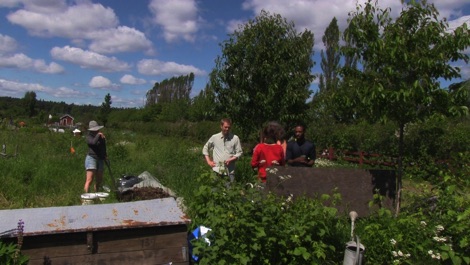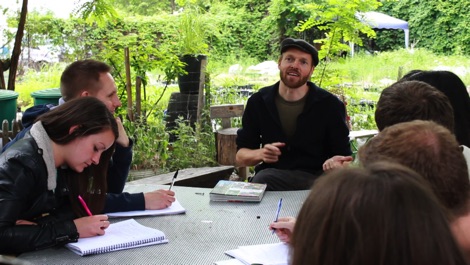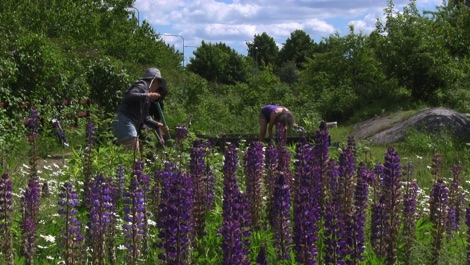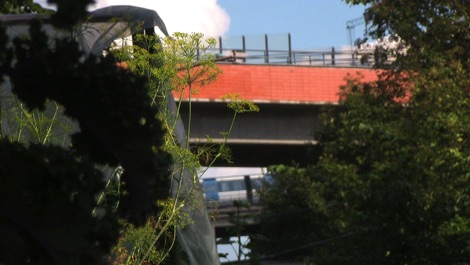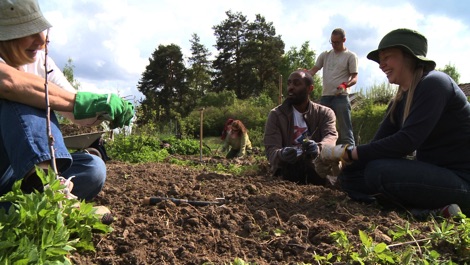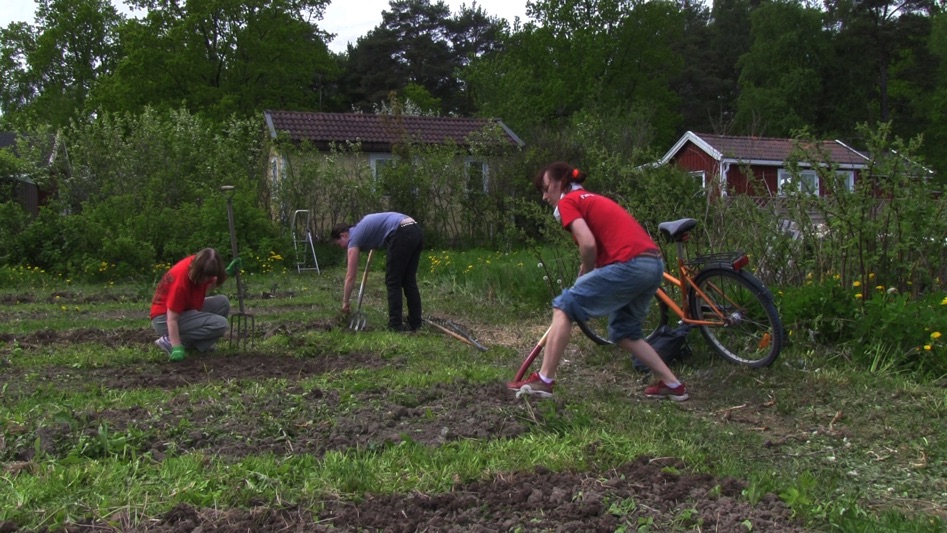
INTRODUCTION
This homepage and the films portrayed at this site illustrate how Urban Green Commons could contribute to make cities more green, fair and attractive to live in.
Urban Green Commons (UGCs) are green spaces in cities that are collectively organized and managed by the residents themselves (Colding & Barthel 2013). They represent a particular type of property right regimes (Swed: “äganderätter) called common property systems that are different from property rights regimes that are in the hands of private actors and the state and local governments. The term “common” suggests that land and its resources are managed and often owned by a certain community, association or collective of people. A distinctive characteristic of UGCs is that it allows a greater set of urban inhabitants to manage land and natural resources in cities and participate in creation of a livable city.
It is important to recognize that “commons” is not the same as public spaces in cities that are opened to everyone, but rather represent public space organized and managed by a specific interest group or collective of people. Hence, they frame access to land in a limited sense. At the same time they allow for greater public involvement in managing land in cities.
The films series Urban Green Commons: Berlin-Stockholm (Stadsodlingar Berlin-Stockholm) serves to inspire local city residents, urban planners and decision makers to adopt and spread common property initiatives in cities. As the film series portray they could be used in city designs not only to boost ecosystem services, but also to promote socio-cultural benefits in local city districts, fostering cultural integration and intergenerational meetings among people that transcend race, occupation and social class. Hence, the film series present solutions that can be adopted by planners to make cities more socially inclusive for the benefit of both people and nature. In this way the site serves to stimulate the build-up of knowledge around Urban Green Commons and to communicate those insights more broadly in society.
The film series show what can happen when local residents themselves get a chance to dig into the soil, work with their hands, and together with others hold the opportunity to take care of and manage green areas in cities. Clearly, these groups of people contribute to make their cities greener by urban farming and gardening as well as make cities more worthwhile and interesting to live in. The films demonstrate that when local residents themselves are allowed to shape and influence their local neighborhoods they start communicating with one another; hence helps to break isolation and instead builds trust and social capital among themselves. To gather around an activity like urban gardening and farming, city inhabitants become active stewards of the green environment and can make a difference in facing the real challenges that humans face today with climate change and the loss of biological diversity and ecosystem services.
Scientific rationales behind the films and site
The film series is complemented by scientific studies conducted on Urban Green Commons (UGCs) and similar gardening projects in cities, and also by interview films with scholars and researchers that have studied urban farming and gardening. This site also suggests literature for further reading.
Much of the new insights on UGCs have been derived in the research project SUPER (Sustainable Urban Planning for Ecosystem services and Resilience). The aim of the SUPER project is to develop knowledge on how urban spatial planning processes can better integrate ecosystem services so as to nurture urban resilience. It strives to lay a foundation for innovations in urban planning and governance. Innovations are needed to enable cities to navigate change, build local capacity to respond to disturbance and to prepare for uncertainty, in that way enabling transitions to sustainable urban trajectories.
The long-term objective of SUPER is to deliver knowledge of value for practitioners in cities and to generate both theoretical and practice innovations of immediate concern to urban residents, policy makers, and urban planners.
The SUPER-project has been funded through grants by the Swedish Research Council for Environment (FORMAS) within the URBAN-NET programme, which addresses issues of urban sustainability in Europe.
Read more about SUPER at: http://www.beijer.kva.se/ FORMAS is also the key funder behind the films presented here.
We live in an increasingly dominated urban world
Today half the world-population lives in urban areas and by 2030 nearly 60% is expected to live in cities and towns. The amount of the built mass on Earth is predicted to double by the year 2030. In fact, almost two cities the size of Vancouver is currently built each week on planet Earth. This rapid development will produce ever-greater demands on lands inside and outside of cities and particularly on ecosystem services that provide so many benefits to humans like the diversity of plants and animals (biodiversity), clean air and water and the protection against flooding and droughts and other potential harmful climate change effects. http://en.wikipedia.org/wiki/Ecosystem_services ).
While well-planned cities are great to live in it is also important to consider the ecological functions that attractive cities must provide. One undesirable outcome of urbanization is that a higher proportion of people become landless and does not have the possibility to work with their hands and dig into the dirt and soil. Even worse, many children live their life in an asphalt jungle devoid of green and natural elements. Moreover, migrants that formerly lived in rural settings with opportunity to manage land will increasingly be constrained to live in apartments with little opportunity to actively manage and cultivate land and resources unless measures are taken.
Today urbanization commonly leads to impoverished biological metropolitan areas with a diminishing amount of green structures. This development has consequences. Research has shown that cities without ample amount and quality of green areas contribute to ‘environmental generational amnesia’ among city inhabitants (Kahn 1999). This phenomenon is when knowledge about nature and the environment is not passed down from generation to generation. For example, people may think of some natural areas as wilderness based on what they experienced during childhood, but with an increased loss of biodiversity in every generation this baseline becomes more and more diluted. This means that coming generations (children in particular) will have less opportunity to learn about natural processes and ecology in cities and thereby miss what fundamental role nature plays for sustaining human life and social wellbeing. Moreover, in adapting to climate change effects green structures in cities provide a whole range of critical ecosystem services, such as providing meeting places, cooling the air temperature during sudden and unexpected heat waves and buffering against flooding during extreme rainfall. The spread of environmental generational amnesia will also make it harder to get public support for policies that are required in order to effectively deal with climate change and the global loss of biological diversity and ecosystem services.
Urban Green Commons and the key role of land rights in cities
Recent research suggests that urban green commons (UGCs) could help cities to manage both biological and cultural diversity in meaningful and constructive ways (Colding & Barthel 2013). Urban green commons represent green spaces in cities that are collective organized and managed and to which city inhabitants hold the right to manage land. Examples include allotment gardens (Swe: kolonilotter), community gardens, community-managed forests, and green patches at business sites that are managed by employees (Colding et al. 2013).
To help mitigate the growing disconnection of city residents from nature the places where people live and work need to offer meaningful opportunities to interact with ecosystems in cities. Hence, green areas such as parks and other green spaces play a key role in sustaining cities and making them more attractive to live in. In this respect property rights (Swed: “äganderätter”) are important to consider since they influence and determine who owns and holds rights to land and resources and what activities are allowed on these lands. Ownership to land and rights to land resources could be either in private, state- or common (collective) property rights regimes, or in a combination of these.
As the work of Nobel laureate Elinor Ostrom reveals, a number of natural resources throughout the world are successfully governed collectively, contradicting claims that resources need to be privatized or be controlled by the state (or the municipality or city-districts) in order to avoid destruction and overuse. Elinor Ostrom refer to such collective management forms as common property systems, which means that rights to land and resources are in the hands of an identifiable group of people (a collective) that can craft their own rules and norms for managing natural resources.
Cities become increasingly privatized and socially enclosed
There is a growing trend of privatization of land, facilities and services in cities. Social scientists agree that this privatization trend is global and independent of a country’s wealth or political ideology (Webster 2003; Lee and Webster 2006). As a result lands held in the public domain such as parks and other green spaces are increasingly becoming privately owned and enclosed, and often sold and turned into urban developments for construction of housing and shopping areas. The privatization trend further reduces opportunities for urban residents to have meaningful interaction with ecosystems in cities (Colding 2011).
Urban Green Commons (UGCs) represent a worthwhile alternative to privatization of public land since it draws on voluntary (unpaid) forms of land management in contrast to when the state, the local municipality or private actors manage land which always is costly. UGCs represent an economically feasible alternative for taking care of public land since this is done by local interest groups and draws on their self interest. In this sense local people become an active part of shaping their local neighborhoods and become more active in the care and outcome of their local area, facilitating benign norm development. At the same time, research shows that UGCs hold the potential to provide both key socio-cultural services and ecological services to city residents.
The purpose of the film series
The film series Urban Green Commons: Berlin-Stockholm (Stadsodlingar Berlin-Stockholm) draws ultimately on the notion that common property-rights regimes offer important alternatives to privatization of land in cities. The film series consists of five films that each deals with urban gardening and farming. We refer to this type of gardens as “public access community gardens”, or PAC-gardens, which represent public green spaces in cities that are collectively managed by civil society groups and to which the general public is invited to take care of the land and conduct gardening and food cultivation (Bendt et al. 2013).
Research shows that PAC-gardens can be ascribed for creating broader public participation and greater diversity in the content of learning about local sustainability in cities. Such learning streams include learning about gardening and local ecological conditions; about urban politics and use of space, and about social entrepreneurship. PAC-gardens differ from more closed forms of urban gardening such as allotment gardens and gated community gardens by being more open to the broader public. Moreover, participation in gardening and farming activities is less formalized and less time consuming and economically costly. PAC-gardens intertwine gardening with social, political and economic practices that can create broader and more heterogeneous learning environments about social–ecological conditions, and help develop sense-of-place and restoration of degraded neighborhoods.
The groups of films presented on this homepage focus each on a number of distinct thematic features. Garden on the Track and Prinzessinnengärten both display PAC-gardens that are run as a social enterprise and have been initiated by key individuals. Both films show how organic gardening and food cultivation are carried out in mobile cultivation boxes. This characteristic is a reflection of that both gardens have a highly unstable type of property right regime, where lease rights (Swed: “arrende”) to land is extremely short-term and usually represent an interim use for vacant land awaiting urban development. Garden on the Track was inspired by Prinzessinnengärten, which in turn was inspired by urban farming in Havana, Cuba.
The Kärrtorps Guerilla Gardening is an example where gardening takes place in the absence of any legally defined property rights, such as on abandoned sites, an area that is not being cared for, or on property owned by someone else like parkland in the local municipality. Guerilla Gardening encompasses gardeners who spill over their legal borders to gardeners with political influences who seek to achieve change by using guerrilla gardening as a form of direct action. It has implications for land rights and property reforms; aiming to highlight land ownership issues to provide a new purpose for land or reclaim land that is perceived to be in neglect or misused. Guerilla gardening draws on the first community gardens that was established in United States in New York City in the early 1970s.
The key theme of Bushgraben - Gerhard Borné is centered on how a garden and food cultivation site could be developed around religious pretexts, where spiritual values and beliefs about nature form the basis for management. This garden is located in a villa neighborhood and initiated and run by a priest. The garden and its food cultivation activities also serve the purpose to be restorative for persons that are mentally fatigue or disabled. In this sense the garden fits the category of representing a biophila garden. There is a whole cadre of community gardens around the world, especially in the U.S., that is grounded in the notion of biophilia, which means that there is an instinctive bond between human beings and other living systems. Biologists Edward O. Wilson introduced and popularized the Biophilia concept in his book, Biophilia (1984). See more on: http://www.ecologyandsociety.org/vol17/iss2/art5/
In Folkodlarna i Skarpnäck the key theme is spreading knowledge about organic food cultivation and gardening and producing locally produced foods. The association consists of 20 active members that started cultivating foods in the allotment area known as Skarpnäcks Fritidsträdgårdar in 2009. Gardening on allotment areas is usually a very stable property right in Sweden with lease rights of duration of 25 years or more (Colding et al. 2013). In conjunction to that the city district planned to rebuild a local park in Skarpnäck (Indianparken), the association also received permission in June 2011 to start cultivating food in the park. A common thread among members is the dire need to change consumption preferences and behaviors and providing coming generations with a meaningful alternative to shopping.
What does science say about Urban Green Commons?
There is an increasing scientific interest in urban gardening and urban common property systems. The film series support and complements several findings on UGCs that has been demonstrated in the scientific literature. For example, research on community gardening shows that lease durations of land closely correlate with the appearance of gardens, with gardens having long-term leases demonstrating a sense of permanency with an abundance of slow-growing trees, perennials, lawns and features such as benches, gazebos, and brick paths (Colding 2011). Hence, as property rights theory would predict, community residents are more willing to invest in gardening activities the longer the leases they have. Research also shows that UGCs hold the potential to provide both key socio-cultural services and ecological services to city residents. Table 1 and 2 (below) summarize some key socio-cultural and ecological services that urban green commons provide.
Table 1. A selection of socio-cultural services that urban green commons have been shown to generate in scientific studies.
Socio-cultural services and benefits of urban green commons
Nature values
Bringing some sense of nature into an area (Schmelzkopf 1996)
Positive effects on surrounding property values (Voicu & Been 2006)
Inspiration
Act as a mental stimulus for elderly people delaying the onset of dementia (Grahn 1993)
Nature education
Gardens as arenas where urban residents can shape their relation to nature and may learn the importance of positive human inputs into landscape most clearly (Rodhe and Kendle 1997)
Recreation
Safe environment for outdoor activities (Shinew et al. 2004)
Physical and mental health benefits (Kaplan & Kaplan 1989; Select Committee 1998; Grahn 2003; Maas et al. 2006)
Social relations
Build a sense of community among neighbors; improve social contacts (Lewis 1992; Select Committee 1998)
Abate criminal activity (Schmelzkopf 1996)
Fostering positive intercultural and racial relationships (Linn 1999; Shinew et al. 2004)
Table 2. A selection of ecosystem services generated by urban green commons (Source: based and modified from Colding 2011 and Colding et al. 2013c)
Ecosystem services generated by urban green commons
Provisioning services
Food (fruits, vegetables, honey)
Source of food and subsistence income
Ornamental resources
Regulating services
Improved air filtration
Erosion control and regulation
Noise reduction
Nutrient retention
Pest regulation
Regulation of microclimate
Surface water drainage
Air cooling effects
Supporting services
Habitat for flora and fauna
Seed banks for rare vegetable species
Soil formation
Seed dispersal
Pollination
Water cycling
For Swedish readers and viewers that would like to learn more about ecosystem services in Swedish see: http://www.tmr.sll.se/Publikationer/2013/Ekosystemtjanster-i-Stockholmsregionen
Cited References
Bendt, P., Barthel, S. and Colding, J. 2013. Civic greening and environmental learning in public-access community gardens in Berlin. Landscape and Urban Planning 109: 18–30.
Colding, J. 2011. Creating incentives for increased public engagement in ecosystem management through urban commons. Pages 101-124 in Adapting Institutions: Governance, Complexity and Social-Ecological Resilience. Emily Boyd and Carl Folke (Eds.). Cambridge University Press, Cambridge, UK.
Colding, J. and S. Barthel (2013). The potential of ‘Urban Green Commons’ in the resilience building of cities, Ecological Economics 86:156–166.
Colding, J., Barthel, S., Bendt, P., Snep, R. vander Knaap, W. and Ernstson, H. 2013. Urban green commons: Insights on urban common property systems. Global Environ. Change (2013), http://dx.doi.org/10.1016/j.gloenvcha.2013.05.006
Kahn, P.H., Jr. (1999). The human relationship with nature: Development and culture. Cambridge, MA: MIT Press.
Kaplan, R. and Kaplan, S. 1989. The experience of nature – a psychological perspective. Cambridge University Press,
Cambridge, UK. Lee, S. and Webster, C. 2006. Enclosure of the urban commons. GeoJournal 66: 27-42.
Linn, K. 1999. Reclaiming the sacred commons. New Village 1: 42-49.
Maas et al. 2006. Green space, urbanity, and health: how strong is the relation? J Epidemiol Community Health 2006;60:587-592 doi:10.1136/jech.2005.043125
Rhode and Kendle 1997. Nature for people. Pp. 319-335. In Kendle, T. and Forbes, S. (eds.). Urban Nature Conservation. E & FN Spon, London.
Select Committee 1998. The United Kingdom Parliament, Select Committee on Environmental, Transport, and Regional Affairs Fifth Report to The House of Commons (1998).
Shinew, K.J., Glover, T.D. and Parry, D.C. 2004. Leisure spaces as potential sites for interracial interaction: Community gardens in urban areas. Journal of Leisure Research 36: 336-355.
Schmelzkopf, K. 1996. Urban community gardens as a contested space. Geographical Review 85: 369-381.
Voicu, I. and Been, V. 2006. The effect of community gardens on neighboring property values. Law and Economic Research Paper Series, Working Paper 06-09.

